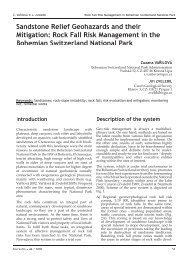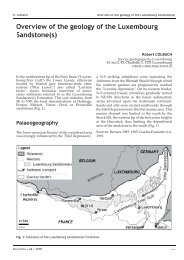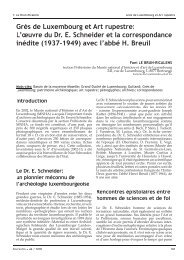Weathering morphologies of the Fontainebleau Sandstone and ...
Weathering morphologies of the Fontainebleau Sandstone and ...
Weathering morphologies of the Fontainebleau Sandstone and ...
Create successful ePaper yourself
Turn your PDF publications into a flip-book with our unique Google optimized e-Paper software.
M. Thiry <strong>Wea<strong>the</strong>ring</strong> <strong>morphologies</strong> <strong>of</strong> <strong>the</strong> <strong>Fontainebleau</strong> <strong>S<strong>and</strong>stone</strong> <strong>and</strong> related silica mobilityRIDGE"whale backs" <strong>of</strong> bare s<strong>and</strong>stonediscontinuous s<strong>and</strong> coverESCARPMENTdrawing <strong>of</strong> <strong>the</strong> s<strong>and</strong> - breakup <strong>of</strong> <strong>the</strong>ridge - labyrinth-like corridorsSLOPErock chaos – dome-likeboulders with silica crusts50-100 mFig. 1: Schematic sketch showing <strong>the</strong> dismantling <strong>of</strong> <strong>the</strong> <strong>Fontainebleau</strong> <strong>S<strong>and</strong>stone</strong> ridges by vertical <strong>and</strong> horizontalfractures <strong>and</strong> development <strong>of</strong> <strong>the</strong> dome-like shaped boulders on <strong>the</strong> s<strong>and</strong> slopes.Dome-like <strong>morphologies</strong> with silicacrustsAer break up, <strong>the</strong> blocks acquire rounded shapes.In this way, at <strong>the</strong> ridge escarpment, <strong>the</strong> s<strong>and</strong>stoneplates resulting from horizontal fracturing becomerounded at <strong>the</strong>ir upper edge, whereas <strong>the</strong>ir lowerplane show a prominent lipp-like flange. The silicadeposits formed in <strong>the</strong> fractures are put into reliefby this wea<strong>the</strong>ring.The more massive facies also round out <strong>and</strong> formdome-shaped boulders at <strong>the</strong> top <strong>of</strong> <strong>the</strong> ridges <strong>and</strong> on<strong>the</strong> rockfall on <strong>the</strong> s<strong>and</strong>y slopes. Boulders diminishregularly in size away from <strong>the</strong> escarpment <strong>and</strong> <strong>the</strong>domes become coated with a 0.5 to 2 cm-thick silicacrust, harder than <strong>the</strong> s<strong>and</strong>stone body (Fig. 2E &2F). This silica crust is restricted to <strong>the</strong> top <strong>of</strong> <strong>the</strong>domes, <strong>and</strong> is lacking on <strong>the</strong> lower parts <strong>and</strong> on <strong>the</strong>overhanging surfaces. It is put into relief by differentialalteration at <strong>the</strong> periphery <strong>of</strong> <strong>the</strong> domes.Thin sections across <strong>the</strong> silica crust show that <strong>the</strong>overgrow<strong>the</strong>d quartz grains <strong>of</strong> <strong>the</strong> s<strong>and</strong>stone aresplit <strong>of</strong>f by tiny cracks, from 1 to 20 µm-wide,along <strong>the</strong> grain contacts, mostly parallel to <strong>the</strong> crustsurface. Quartz grains are only seldom fractured.These cracks are cemented by brown to clear opalwhich forms <strong>the</strong> harder <strong>and</strong> less alterable crust at <strong>the</strong>top <strong>of</strong> <strong>the</strong> domes. Nor empty cracks, nor cracks withclay or organic-rich illuviations are never observed.This may indicate that opal precipation itself bringsup <strong>the</strong> disjunction <strong>of</strong> <strong>the</strong> quartz grains.Polygonal dissolution groovesPolygonal networks <strong>of</strong> grooves develop on <strong>the</strong>dome flanks <strong>and</strong> on <strong>the</strong> overhanging surfaces(Fig. 2G). Such polygonal grooves never impressin <strong>the</strong> silica crusts capping <strong>the</strong> domes <strong>and</strong> coating<strong>the</strong> fractures. The network is generally isometric,forming polygones <strong>of</strong> about 5 to 10 cm in diameter,<strong>the</strong>y may become in horizontal elongated. Inplaces, <strong>the</strong> layout <strong>of</strong> <strong>the</strong> overhanging surfaces <strong>of</strong><strong>the</strong> s<strong>and</strong>stone blocks, <strong>and</strong> even larger pans, clearlypoint out that <strong>the</strong>se surfaces are related to a formerl<strong>and</strong>surface supporting a paleosol which has beenstripped <strong>of</strong>f by erosion. Thus development <strong>of</strong> <strong>the</strong>polygonal networks <strong>of</strong> grooves may be relatedto processes occuring within <strong>the</strong> soil <strong>and</strong> not incontact with <strong>the</strong> atmosphere.Thin sections show development <strong>of</strong> large intergranularvoids which come with preferentialdissolution <strong>of</strong> <strong>the</strong> quartz overgrowths. Thesevoids remain empty, or may contain tiny quartzchips oen blended with iron oxydes. No preexistingstructure within <strong>the</strong> s<strong>and</strong>stone is relatedto <strong>the</strong> development <strong>of</strong> <strong>the</strong> dissolution voids, nor<strong>the</strong> polygonal grooves.Never<strong>the</strong>less, if <strong>the</strong> development <strong>of</strong> <strong>the</strong> polygonalgrooves indicates wea<strong>the</strong>ring-dissolution rocesses,<strong>the</strong> mechanism leading to <strong>the</strong> polygonal structureremains unknown.48 Ferrantia • 44 / 2005













